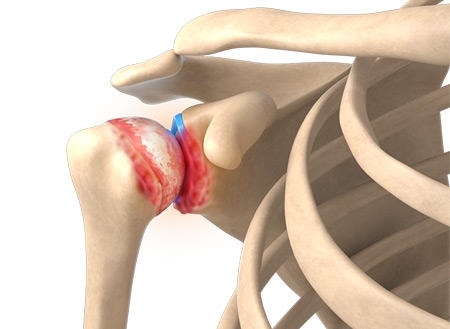When it comes to shoulder pain in aging adults, osteoarthritis and rotator cuff tears are common sources. Patients often struggle with pain, particularly at night, as well as stiffness and weakness. But, what happens when a rotator cuff tear is present in a shoulder that is also arthritic?
Conservative management can be considered. The deltoid muscle can be re-trained with therapeutic exercise, either with a physician-guided home exercise program or formal physical therapy, to help accommodate for the deficient rotator cuff. Different injections such as cortisone, hyaluronic acid, or platelet rich plasma could be considered to help mitigate pain and better facilitate therapeutic exercise. Patients may find their symptoms are manageable with these treatments. However, none of these injections will heal the shoulder.
Surgical options of varying complexity and invasiveness can be discussed if conservative measures do not adequately alleviate symptoms. Most simply, a ‘clean out procedure’ or arthroscopic debridement could be performed. This surgical option would be the most unpredictable in terms of the outcome a patient will experience. However, it comes with the least amount of risk and has a minimal recovery. A debridement will not restore strength.
Depending on the severity of arthritis and degree of tearing, a rotator cuff repair could be considered. If the repair is successful, this option should restore strength. It is possible the tear is found to be irreparable, or at least partially irreparable, at the time of surgery. If this were to be the case, it could simply be debrided or a tendon transfer or shoulder replacement procedure could prevail. A successful tendon transfer procedure would likely improve normal strength if successful as well.
With any procedure aimed at repairing or debriding the rotator cuff, it is possible for a patient to experience residual pain due to the arthritic changes in the joint. None of the previously mentioned surgical options render a joint replacement unattainable. However, once the joint is replaced, a patient cannot go back to a lesser procedure.
To more definitively treat both the rotator cuff tear as well as the arthritic changes in the joint,a reverse total shoulder arthroplasty is a good option. This is the most reliable surgery in terms of outcome as well as the best chance of not needing subsequent surgery. A reverse replacement will not restore strength out and away from the body and may result in somewhat decreased motion compared to pre-op.
Ultimately, clinical decision making for patients in this scenario is largely based on their lifestyle and preferred activities. Some patients prefer to keep the shoulder as ‘normal’ as possible in order to pursue their desired recreation or workplace tasks. Others prefer to decrease the risk of multiple surgeries and proceed with shoulder replacement.




